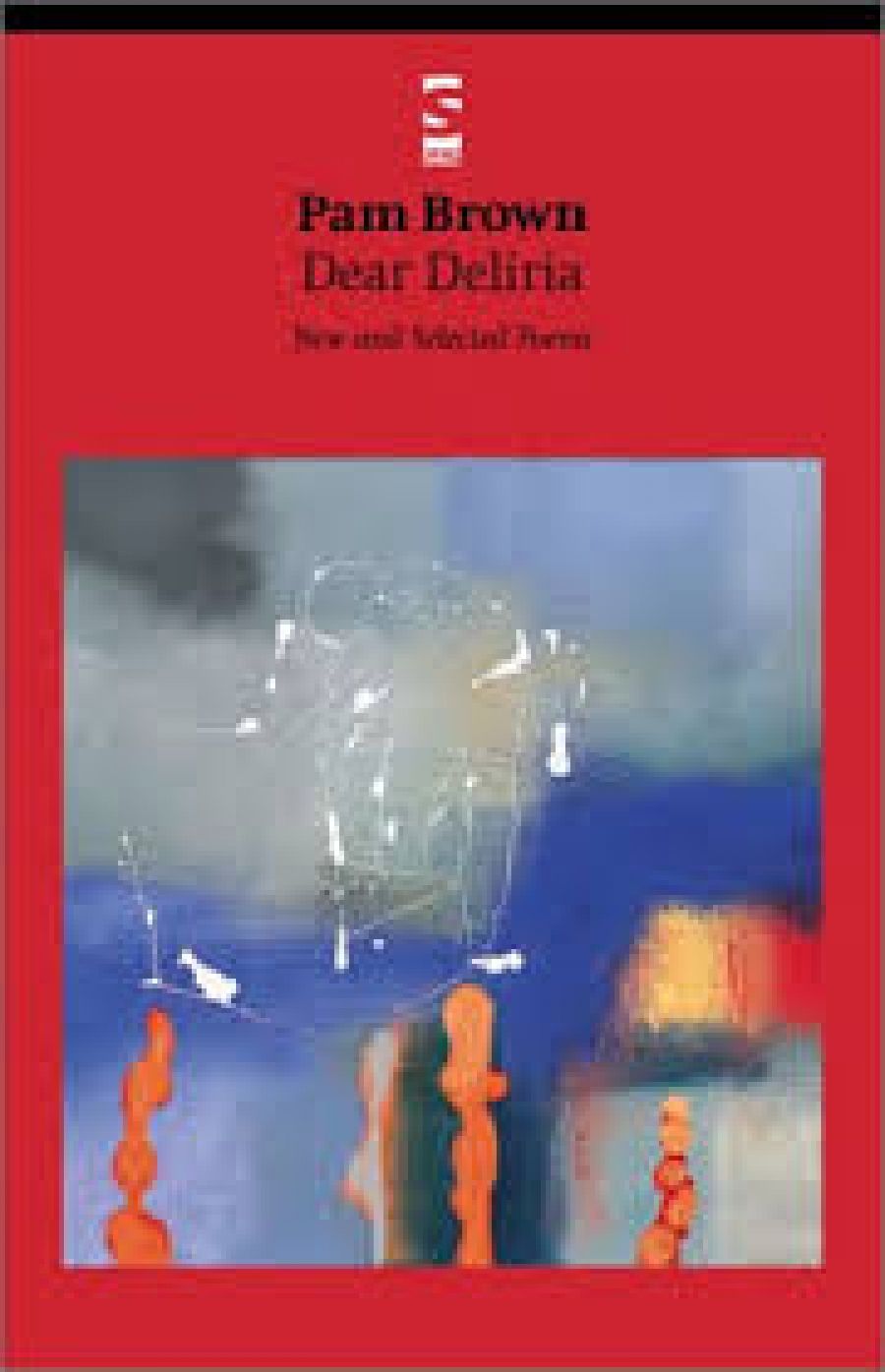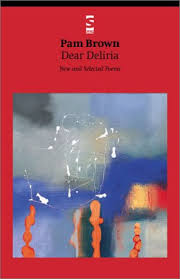
- Free Article: No
- Contents Category: Poetry
- Review Article: Yes
- Article Title: Out There
- Online Only: No
- Custom Highlight Text:
It is a Pam Brown moment when, flicking through her Dear Deliria, I read of ‘historic butter sculptures’ and hear at the same time David Bowie on the stereo singing ‘yak-butter statues’. It’s a Pam Brown moment because her poetry is one of incidents and coincidence. In its interest in both the quotidian and in critique, Brown’s poetry illustrates the endless interplay between texts and contexts, between art and life. These latter categories are most vivid in Brown’s poems when they are collapsing into each other – like drunk friends at a party.
- Book 1 Title: Text Thing
- Book 1 Biblio: Little Esther, $23 pb, 136 pp
- Book 2 Title: Dear Deliria
- Book 2 Subtitle: New and selected poems
- Book 2 Biblio: Salt, $21.95 pb, 159 pp
- Book 2 Cover Small (400 x 600):

- Book 2 Cover (800 x 1200):

Having been involved in experimental theatre, as well as having been a script writer, a poetry editor, the author of numerous poetry books and chapbooks, and the bassist of Clitoris Band (ah, 1970s feminist rock), Brown is more qualified than most to figure life as a long discontinuous poetic sequence. Her poems often centre on small events (listening to the car stereo, going to an art exhibition) that open onto related (but not merely ‘revelatory’) moments that illustrate the endlessness of observation, analysis and association: ‘Patti Smith was right’; ‘evening’s delicate / fairy lights / spell out / multiplex’; ‘I reckon / it’s hairdos, / mainly, / that distinguish / temporality.’ (There’s a pun in that last one, and the ‘mainly’ shows Brown’s mastery of the flip tone. Flip, but not too flip.) Even memory is a kind of event. To have a self is to bring that self continually into being, as the emphasis on the present tense in these poems suggests.
The fairy lights spell out ‘Multiplex’ because they are on a crane advertising the building company of that name. This kind of imagery is common in Brown’s work, part of the postmodern chattiness of a bricoleur attuned to both things-in-themselves and to the ideology of those things’ commercial and cultural reality. (We also find lucozade, ‘a blank / TAB trifecta ticket’, ‘the securicom buzzer’, Nicorette, TOYS R US, and so on.) But the image of the lights is also an apposite one for Brown’s work generally, for its delicacy amidst brute fact. Brown’s poems are themselves multiplex. They have many interrelated features, there’s lots going on, but they are also (to invoke the communications sense of the word) like single channels that can transmit more than one signal simultaneously. The butter sculptures are a childhood memory and a critique of colonial culture. The poems are streams of data and highly arranged works.
None of this is to say that Brown is solemn or portentous. Indeed, there is something uniquely wry about Brown’s work. How can you not admire a poet who calls a book of poems Text Thing? (Dear Deliria is pretty good, too.) Text Thing (published by the indefatigably left-of-field Little Esther press) is Brown’s first collection since 50/50 in 1997, and it is an equally strong collection.
The ‘indie’ look of Little Esther books is attractive, but sometimes the casual attitude infects the editorial style. Surely em-dashes could be used instead of hyphens when needed? To appropriate Ivor Indyk’s description of John Forbes, there is an awkward grace about Text Thing. Part of this comes from the strange euphony of Brown’s work. ‘Funk Descending’ begins ‘celebrating / a wobbly / new world declaration’. Such moments mean more than might be immediately apparent, though some of Brown’s most exuberant work (an exuberance that sometimes recalls the New Yorker Frank O’Hara) occurs when she lets it rip sonically:
roused by finger-clicking
at the end of Satellite of Love
dozy cuckoos cuddle up
in another arcadia
Brown’s strange music is also seen in her sometimes-arcane lexis: ‘fibrillates’, ‘cladistics’, ‘pleonasm’.
Browns second New and Selected, Dear Deliria, is published, stylishly as ever, by Salt, and is surely unique among Selected Poems in its total indifference towards giving the casual reader a sense of which books the poems originally come from. Intriguingly, Dear Deliria is put together, and reads, like a collection rather than a selection. There is an emphasis on 50/50 and Text Thing, but otherwise Brown gives few clues about how she views her career, undermining facile notions of ‘development’.
The poet whose work to which Brown most clearly shows a family resemblance is Laurie Duggan. Brown, like Duggan, often seems autobiographical, but is not a confessional poet. Much of the artistry of both poets lies in their use of tone, something that leads to a peculiar kind of erudite, irreverent humour: ‘reading John Clare’s / “Shepherd’s Calendar” / it seems obvious / he wasn’t “mad” / just bored.’ Closer to home is the self-directed gaze of irony: ‘so full of / hashish (probably) / that you thought / Fitzroy / was somewhere.’ (There’s that undercutting parenthesis again.) Or this superb moment from ‘Front’:
watching
my friends
form
a drunken
committee of two
Like Duggan in Memorials or ‘The Minutes’, or like Ken Bolton (both of whom make appearances in Dear Deliria), the quotidian and the passing of time allow a running commentary on things that draws attention to the speaker’s ‘subject position’ without lapsing into banality or solipsism. Irony, distance and omnivorous interests are the main insulation against such vices, though there are times when Brown’s critical tone can verge on the resentful or at least the cranky: ‘in this town / ideas / come second’ (that’s Adelaide, by the way), or ‘everyone’s indoors watching / crap tv’. Not quite the poète maudit, Brown often emphasises her otherness, as in ‘I / who, when in the workplace, laugh privately’. But the point here is that the emphasis on the self is an emphasis on the local and on the documentary. Moments of crankiness exist, but are not meant to be definitive excoriations of a whole culture.
As all of this suggests, Brown is an immensely interesting poet (rather than, say, a moving one) because of an intellectual quality about her work that is a strange mix of lyricism and critique. Perhaps this is why Duggan has described her as ‘the Mina Loy for the twenty-first century’. Perhaps, too, it is no surprise that the sub-genre that is so often tiresome in the hands of many professional poets – the travel poem, or the things-I-saw-when-at-the-Oz-Council-flat-in-Paris poem – is, in Brown’s hands, the source of some of the best pieces in Dear Deliria. In poems such as ‘Mwà Véé’ and ‘In Brittany’, Brown produces foreign correspondence that is free of cliché and sentiment: ‘this is the kind of place / you’d locate a film /but not live in. / Godard made one here / but none of us /remembers it.’
Talking recently to a friend – a poet, naturally – about Brown’s work, he expressed admiration for it and added that it was ‘out there’. Brown’s poems are out there. However present the poet’s subjectivity, these poems are out in the world; the world of work, friends or home. Such an oxymoronic aesthetic (‘subjective documentary’) suggests an oxymoronic quality to Brown’s work. Her free verse often looks formalist; her poems seem both casual and artfully arranged; there is edginess, but also togetherness.
And so it is a Pam Brown moment when I look up the entry on ‘Mina Loy’ in The Oxford Companion to Twentieth-Century Poetry and read that Loy’s second husband, a boxer, ‘survived three rounds with Jack Johnson’, while the stereo plays Miles Davis’s A Tribute to Jack Johnson. Brown must be the muse of such moments, and as such, her strange and attractive poetry seems to make life stranger and more attractive.


Comments powered by CComment